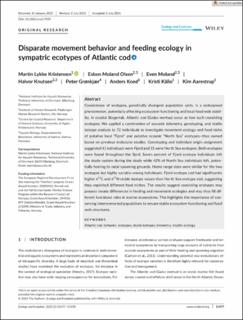| dc.contributor.author | Kristensen, Martin Lykke | |
| dc.contributor.author | Olsen, Esben Moland | |
| dc.contributor.author | Moland, Even | |
| dc.contributor.author | Knutsen, Halvor | |
| dc.contributor.author | Grønkjær, Peter | |
| dc.contributor.author | Koed, Anders | |
| dc.contributor.author | Källo, Kristi | |
| dc.contributor.author | Aarestrup, Kim | |
| dc.date.accessioned | 2021-10-01T07:39:38Z | |
| dc.date.available | 2021-10-01T07:39:38Z | |
| dc.date.created | 2021-08-09T13:21:37Z | |
| dc.date.issued | 2021 | |
| dc.identifier.citation | Ecology and Evolution. 2021, 11 (16), 11477-11490. | en_US |
| dc.identifier.issn | 2045-7758 | |
| dc.identifier.uri | https://hdl.handle.net/11250/2786866 | |
| dc.description.abstract | Coexistence of ecotypes, genetically divergent population units, is a widespread phenomenon, potentially affecting ecosystem functioning and local food web stability. In coastal Skagerrak, Atlantic cod (Gadus morhua) occur as two such coexisting ecotypes. We applied a combination of acoustic telemetry, genotyping, and stable isotope analysis to 72 individuals to investigate movement ecology and food niche of putative local “Fjord” and putative oceanic “North Sea” ecotypes—thus named based on previous molecular studies. Genotyping and individual origin assignment suggested 41 individuals were Fjord and 31 were North Sea ecotypes. Both ecotypes were found throughout the fjord. Seven percent of Fjord ecotype individuals left the study system during the study while 42% of North Sea individuals left, potentially homing to natal spawning grounds. Home range sizes were similar for the two ecotypes but highly variable among individuals. Fjord ecotype cod had significantly higher δ13C and δ15N stable isotope values than North Sea ecotype cod, suggesting they exploited different food niches. The results suggest coexisting ecotypes may possess innate differences in feeding and movement ecologies and may thus fill different functional roles in marine ecosystems. This highlights the importance of conserving interconnected populations to ensure stable ecosystem functioning and food web structures. | en_US |
| dc.language.iso | eng | en_US |
| dc.title | Disparate movement behavior and feeding ecology in sympatric ecotypes of Atlantic cod | en_US |
| dc.type | Peer reviewed | en_US |
| dc.type | Journal article | en_US |
| dc.description.version | publishedVersion | en_US |
| dc.source.pagenumber | 11477-11490 | en_US |
| dc.source.volume | 11 | en_US |
| dc.source.journal | Ecology and Evolution | en_US |
| dc.source.issue | 16 | en_US |
| dc.identifier.doi | 10.1002/ece3.7939 | |
| dc.identifier.cristin | 1924746 | |
| dc.relation.project | EU/20200411 | en_US |
| dc.relation.project | Norges forskningsråd: 294926 | en_US |
| dc.relation.project | Norges forskningsråd: 272090 | en_US |
| cristin.ispublished | true | |
| cristin.fulltext | original | |
| cristin.qualitycode | 1 | |
